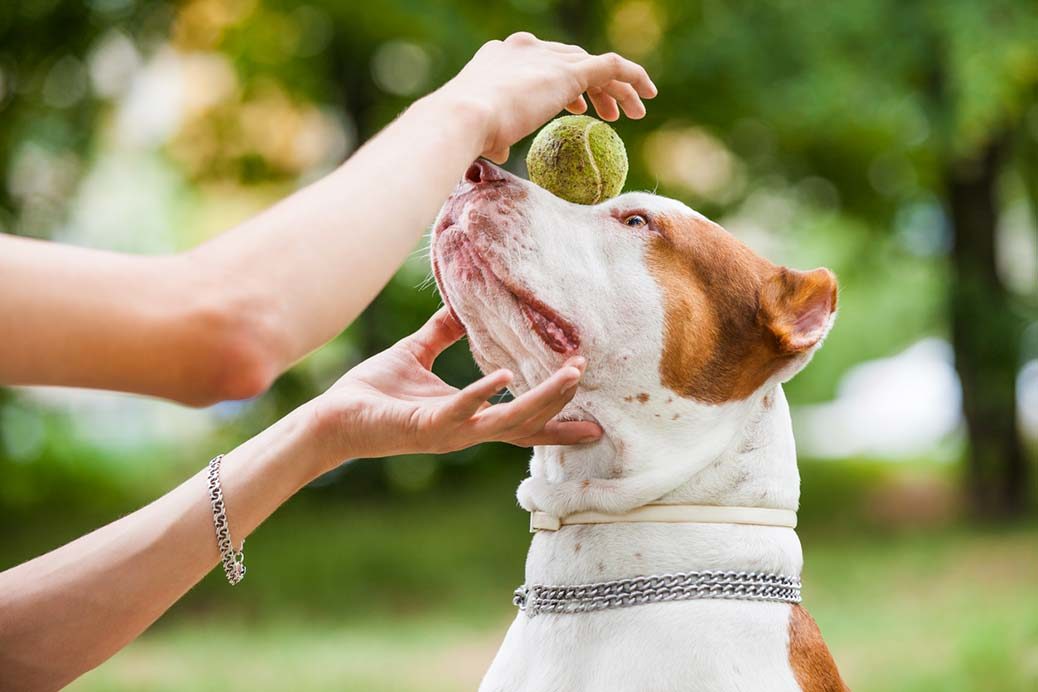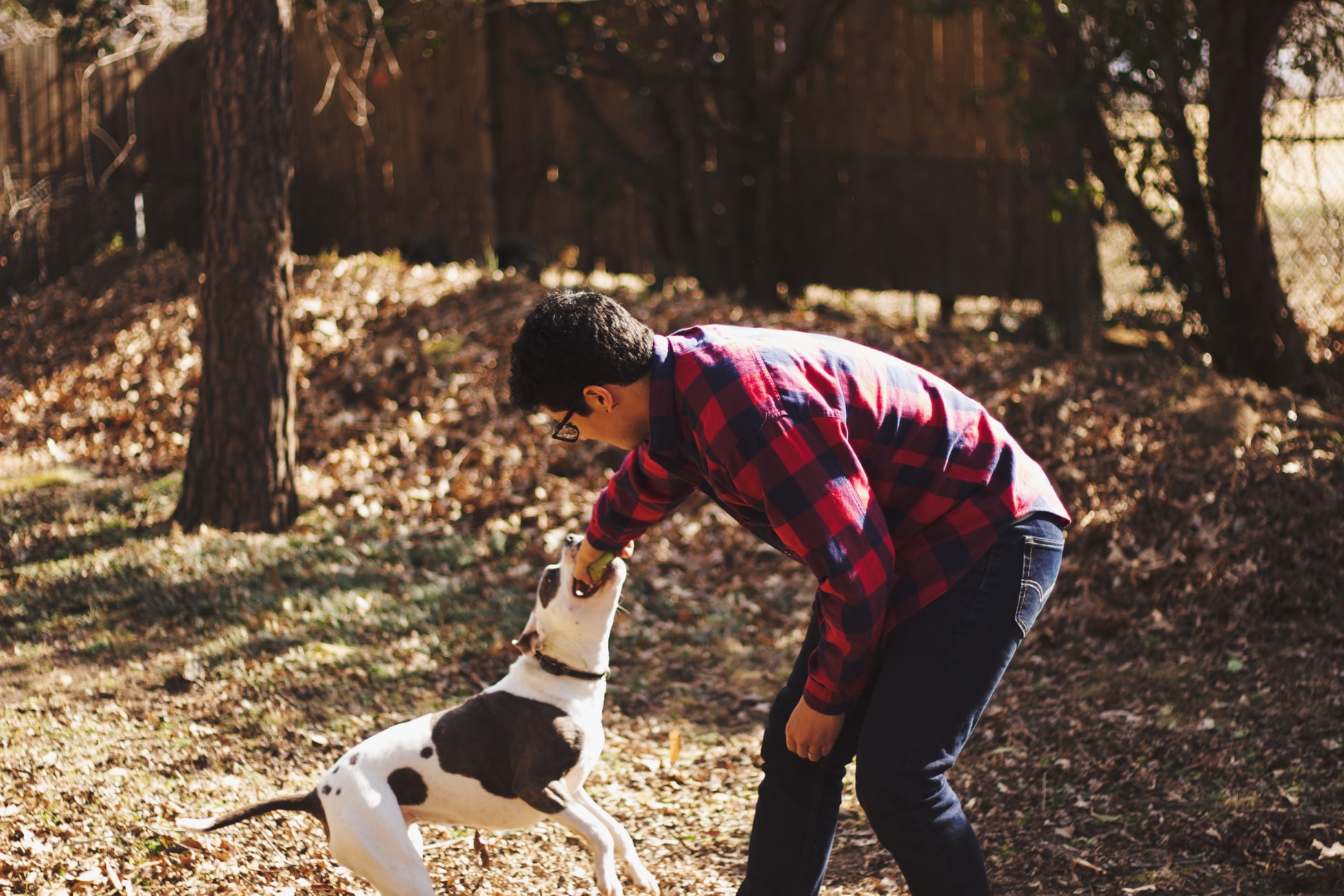How to Teach “Leave It”
In nature, animals often use aggressive threats to prevent others from stealing their possessions. With our pet dogs, however, aggression toward owners is often deemed inappropriate and even dangerous. This resource guarding can be exhibited along a continuum of intensity. A dog may freeze, for example, holding her head low over the food when the owner approaches. She may eat faster with wider gulping motions, growl or give a “hard stare”. At increasing levels of intensity, she may snarl, snap, or bite the owner. Dogs may become possessive over things other than food, such as stolen household items, bones, toys, or sticks.
To prevent resource guarding, your dog should be taught the Leave It command. This command is used to tell your dog that she may earn something even better from you for leaving something she might be tempted to steal and/or guard. To teach the Leave It, begin with a piece of kibble or other relatively boring edible item. Arm yourself with a bowl or treat pouch full of more highly-valued food items, such as tiny pieces of hot dog or chicken. Sit down on the floor with your dog and place the boring food item (the “forbidden” item) on the floor in front of you. As you do so, say “Leave It” in a firm but kind voice and cover the item with your hand. If your dog tries to nose or paw at your hand to get at the food item, hold your hand tight over the item until she quits trying. One second after she quits trying and instead pulls her head away from your hand, praise happily and deliver a treat from your pouch and simultaneously pick up the forbidden food.
Your dog will soon learn not to even try to nose at the food item on the ground. As soon as you place the item down and say “Leave It”, she will look up at you or toward your other hand. Praise and treat when she does. Next, remove your hand a bit from the boring food item on the floor. If she goes toward it, repeat the “Leave It” command and cover the food item. When she looks at you instead, praise and treat from your other hand.
When you can put the forbidden food item on the ground and move your hand away without your dog trying to go after it, begin to move your body away as well. Always say “Leave It” when you place the item on the ground, then move slowly away, praising and treating after gradually increasing periods of time during which your dog is not looking at the item and is instead looking in your direction. Move slowly with this – you always want to be sure you get to the item before she can steal it if she tries!
When you can leave that item on the floor and walk away from it, begin to vary the forbidden item. Try different items from your fridge (e.g., bread, a potato), a dog toy or ball, always being sure to have something more desirable in your treat pouch. Once she is successfully leaving alone a variety of items on the floor, begin to casually drop items from your standing position as you say “Leave It”. Be ready to step on the item if she goes for it. If she does not, praise and treat as usual. Your dog should be learning to walk away from any item as soon as you say “Leave It” while keeping her eyes on you and following you around in expectation of something better. Then try leaving the room with the forbidden item left out. Your dog should be following you out of the room at this point.
When she can do this, begin carrying food treats in your pocket throughout the day to find naturalistic moments to ask her to Leave It. Approach her while she is chewing a bone or toy. Say Leave It when you get to her and offer her a treat from one hand as you remove the item with your other hand. Praise and return the item to her if it’s hers and if she’s allowed to continue chewing it. You can use this when she has stolen something that is not hers, although you want to be sure you are trading her for treats more often each day for her own items than you are trading her for stolen items, lest she learn that the best way to earn treats is to steal something that’s not hers!
As she becomes more reliable with this, continue to issue the Leave It command in various situations throughout the day and praise every time she does so. Over the next month or so, instead of providing a treat every time, try providing a treat only about 75% of the time. For a month after that, provide the treat only about half the time (while still praising every time). In the third month, provide a treat only 25% of the time. After that, provide a treat in exchange for her item just every once in a while, but continue to praise enthusiastically every time. Your dog should by then be happily looking up at you when you approach her as she is chewing a bone or toy, or eating from her food bowl. Her tail might even be wagging as she readily looks away from her valued resource, always hoping you’ve got something even better to bestow upon her!
In nature, animals often use aggressive threats to prevent others from stealing their possessions. With our pet dogs, however, aggression toward owners is often deemed inappropriate and even dangerous. This resource guarding can be exhibited along a continuum of intensity. A dog may freeze, for example, holding her head low over the food when the owner approaches. She may eat faster with wider gulping motions, growl or give a “hard stare”. At increasing levels of intensity, she may snarl, snap, or bite the owner. Dogs may become possessive over things other than food, such as stolen household items, bones, toys, or sticks.
To prevent resource guarding, your dog should be taught the Leave It command. This command is used to tell your dog that she may earn something even better from you for leaving something she might be tempted to steal and/or guard. To teach the Leave It, begin with a piece of kibble or other relatively boring edible item. Arm yourself with a bowl or treat pouch full of more highly-valued food items, such as tiny pieces of hot dog or chicken. Sit down on the floor with your dog and place the boring food item (the “forbidden” item) on the floor in front of you. As you do so, say “Leave It” in a firm but kind voice and cover the item with your hand. If your dog tries to nose or paw at your hand to get at the food item, hold your hand tight over the item until she quits trying. One second after she quits trying and instead pulls her head away from your hand, praise happily and deliver a treat from your pouch and simultaneously pick up the forbidden food.
Your dog will soon learn not to even try to nose at the food item on the ground. As soon as you place the item down and say “Leave It”, she will look up at you or toward your other hand. Praise and treat when she does. Next, remove your hand a bit from the boring food item on the floor. If she goes toward it, repeat the “Leave It” command and cover the food item. When she looks at you instead, praise and treat from your other hand.
When you can put the forbidden food item on the ground and move your hand away without your dog trying to go after it, begin to move your body away as well. Always say “Leave It” when you place the item on the ground, then move slowly away, praising and treating after gradually increasing periods of time during which your dog is not looking at the item and is instead looking in your direction. Move slowly with this – you always want to be sure you get to the item before she can steal it if she tries!
When you can leave that item on the floor and walk away from it, begin to vary the forbidden item. Try different items from your fridge (e.g., bread, a potato), a dog toy or ball, always being sure to have something more desirable in your treat pouch. Once she is successfully leaving alone a variety of items on the floor, begin to casually drop items from your standing position as you say “Leave It”. Be ready to step on the item if she goes for it. If she does not, praise and treat as usual. Your dog should be learning to walk away from any item as soon as you say “Leave It” while keeping her eyes on you and following you around in expectation of something better. Then try leaving the room with the forbidden item left out. Your dog should be following you out of the room at this point.
When she can do this, begin carrying food treats in your pocket throughout the day to find naturalistic moments to ask her to Leave It. Approach her while she is chewing a bone or toy. Say Leave It when you get to her and offer her a treat from one hand as you remove the item with your other hand. Praise and return the item to her if it’s hers and if she’s allowed to continue chewing it. You can use this when she has stolen something that is not hers, although you want to be sure you are trading her for treats more often each day for her own items than you are trading her for stolen items, lest she learn that the best way to earn treats is to steal something that’s not hers!
As she becomes more reliable with this, continue to issue the Leave It command in various situations throughout the day and praise every time she does so. Over the next month or so, instead of providing a treat every time, try providing a treat only about 75% of the time. For a month after that, provide the treat only about half the time (while still praising every time). In the third month, provide a treat only 25% of the time. After that, provide a treat in exchange for her item just every once in a while, but continue to praise enthusiastically every time. Your dog should by then be happily looking up at you when you approach her as she is chewing a bone or toy, or eating from her food bowl. Her tail might even be wagging as she readily looks away from her valued resource, always hoping you’ve got something even better to bestow upon her!






